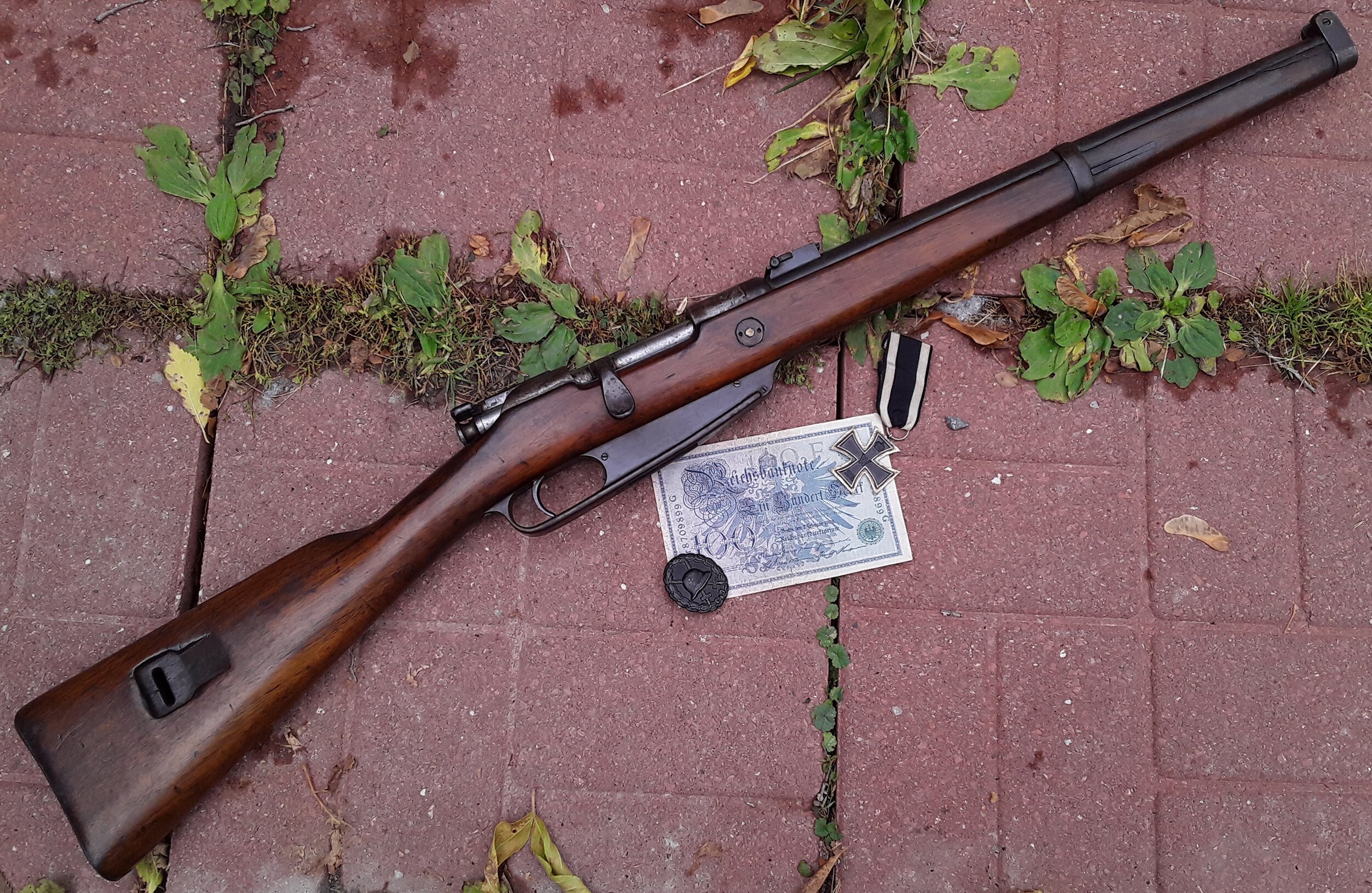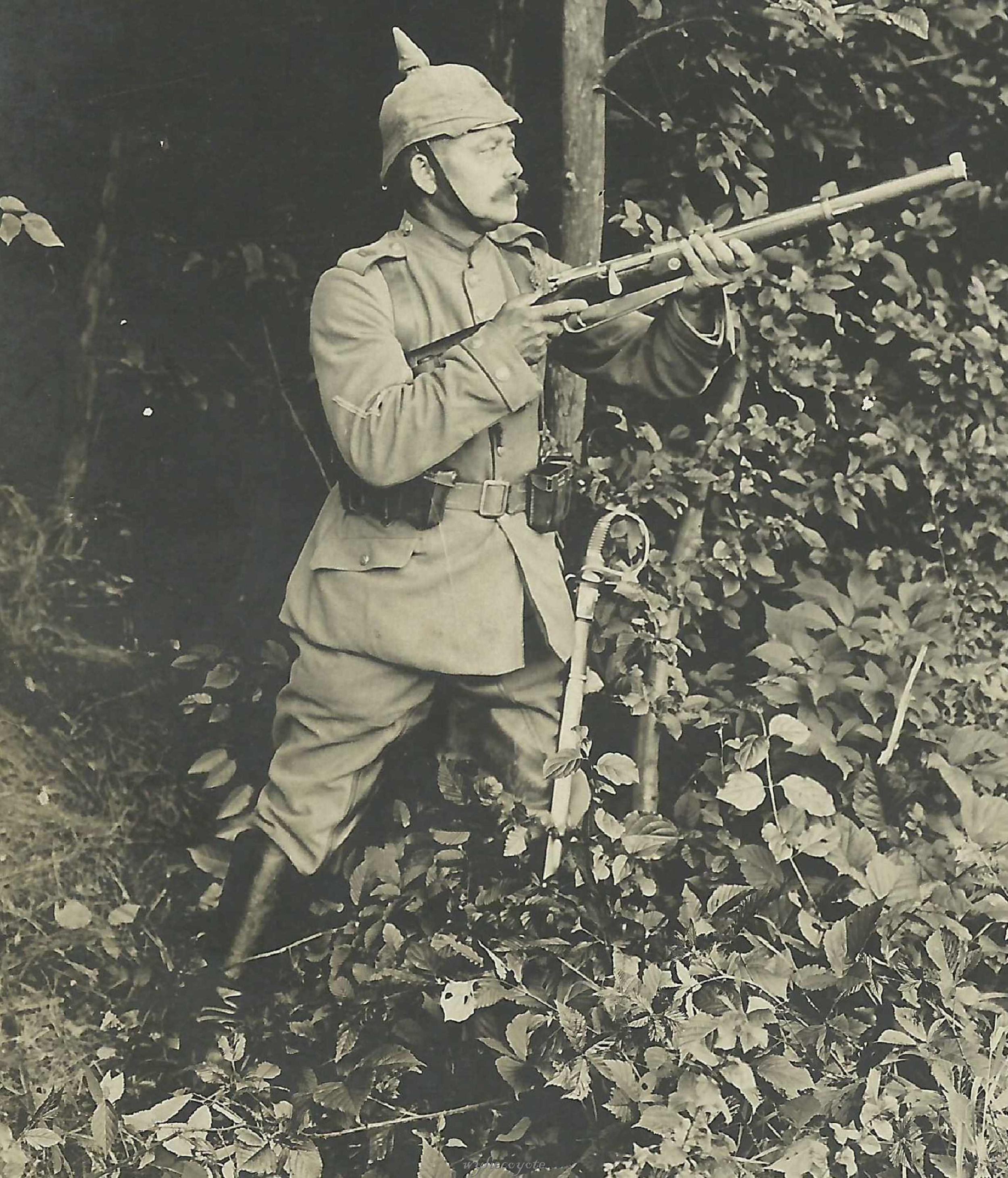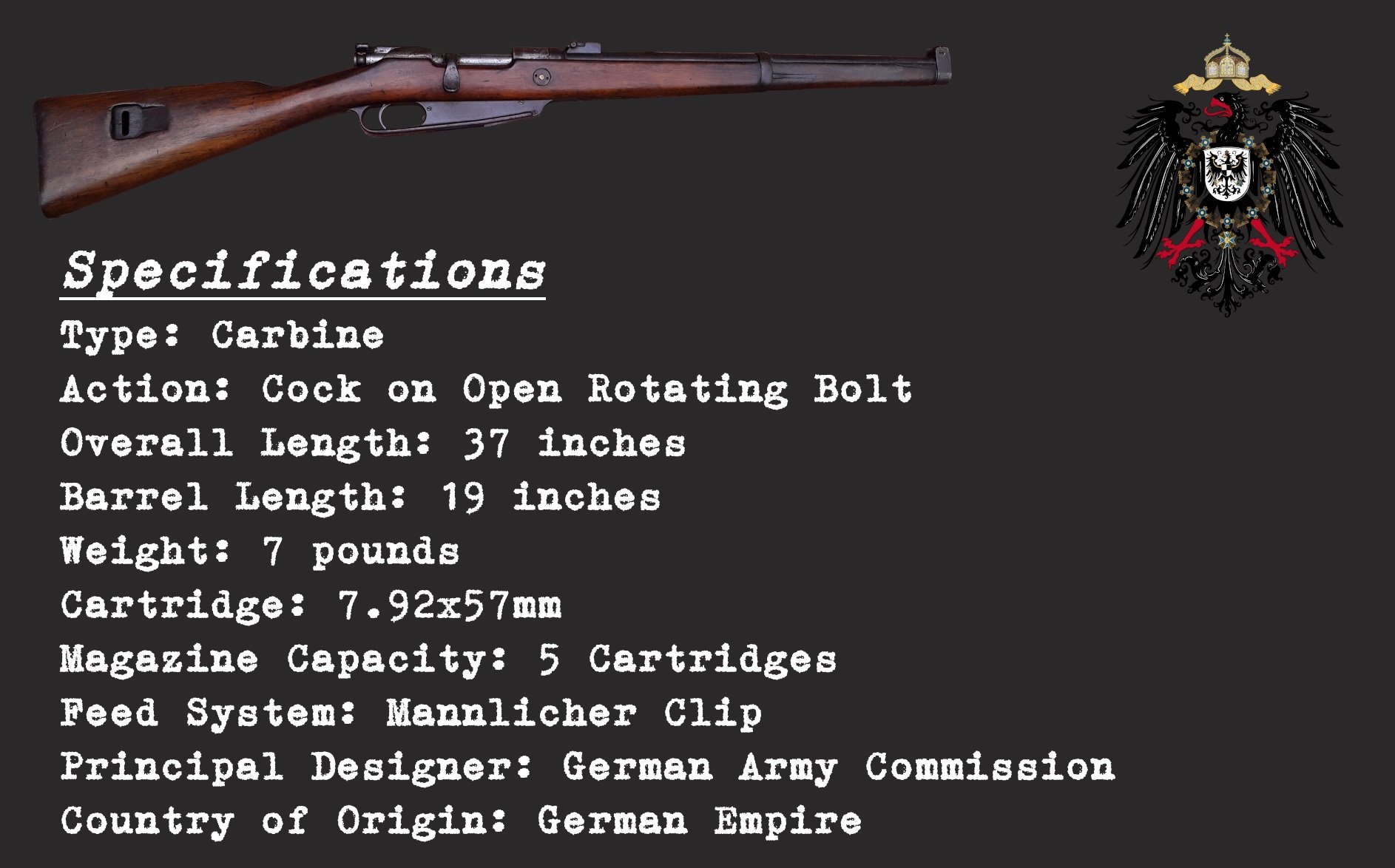Kar88
The German Karabiner 1888 was the first smokeless powder carbine issued by the German Empire, but would survive until the end of the First World War
The Kar88, shown with a 100 Mark banknote from 1908, Iron Cross Second Class and Black Wound Badge
For October of 2020 is the German Karabiner 1888, a carbine developed by the Germans as a complement to the Gewehr 88 “commission rifle” for issue to cavalry and specialist troops. Like its infantry rifle counterpart it chambered a round nose 7.92x57mm cartridge and fed from a five round magazine, using a Mannlicher clip system. It also retained the distinctive metal barrel jacket designed by Armand Mieg, giving the rifle the illusion of a very thick barrel profile. The carbine, however, differed in more than just length: it was fitted with a bent, flattened “spoon” bolt handle, a slotted butt for a side mounted sling, and a blunt nose cap that integrated the front sight. It had no provision for a bayonet.
7.92x57mm cartridge in its original M1888 form, with a loading clip - Wikipedia
Originally, the Kar88 was produced by the private firms C.G. Haenel and V.C. Schilling, but various issues resulted in the Imperial arsenal at Erfurt being issued orders for the carbine as well, producing our example today in 1893.
The receiver of the Kar88, note the Imperial Crown marking of a government arsenal like Erfurt, along with the year of production. The “S” marking indicates rechambering to the newer 7.92x57mmS spitzer cartridge
In 1898 the new Mauser design was approved for issue and began to replace the 1888 series, the Gewehr 98 and Kar98 replacing the Gewehr 88 and Kar88 respectively. This would not be the end of the Kar88, however, as with the adoption of spitzer cartridges in 1903 most rifles in the 7.92mm were altered to accept the improved bullet and cartridge, including a large number of the older 1888 models. In 1905 most of the Gewehr 88 rifles were also modified to accept the charger clips of the Gewehr 98 and redesignated Gewehr 88/05, but the carbines escaped these alterations.
The reason for this came from the original Kar98, as attempts to modify these had resulted in excessive muzzle flash, concussion, and recoil, mandating a slightly longer carbine, a program which resulted in the Kar98AZ. In turn, the decision was made to not perform major alterations on the Kar88, and although modified to accept the spitzer cartridge they were intended to be used as a rear line carbine and would be issued the remaining stocks of the older M88 cartridge.
Despite its age, the Kar88 proved popular for its light weight and good handling characteristics, and indeed while most Gewehr 88 models were exported as war aid to the Ottoman Empire and Austria-Hungary, the Kar88 mostly remained in German service. The end finally came in 1918, as restrictions on the amount of German military arms due to the Treaty of Versailles came into effect, and the new Weimar Republic elected to eliminate all the obsolete weapons from inventory first, and the 1888 series would be among those removed from service. As a result, the rifle had little role to play in future conflicts.
The Kar.88. model designation on the receiver wall. The n.m. marking signifies “Neues Material”, as the alloy of the steel was improved as production increased
The Kar88 also had a sister, the Gewehr 91, which was intended for issue to artillery and other support troops, similar to the Truppe Speciale Carcanos issued by the Italians. This was, despite being designated a rifle, identical to the carbine aside from being fitted with a metal stacking hook under the muzzle end of the stock.
The rear sight, a ladder graduated from 500 to 1200 meters, with a battle sight for (I believe) 300 meters. A secondary battle sight can be flipped up for 400 Meters (another estimate)
This example was made at the Erfurt Imperial Arsenal in 1893, and is unit marked to the Fourth Royal Bavarian Chevau-léger Regiment, which were a uniquely Bavarian light cavalry force in the German Imperial military. Based on a French concept (hence the name), they comprised the majority of the Bavarian cavalry forces by tradition. The 4th Regiment was known as the “König” or King’s regiment, and was considered to be the personal force of the Bavarian monarch. It fought during the Battle of the Frontiers in 1914 as the war opened on the Western Front, serving under Crown Prince Rupprecht during the Battle of Lorraine that formed the southern edge of the larger battle.
They were transferred to serve with the Alpinkorps in 1915, and participated in the Central Powers’ invasion of Romania after that country declared war in 1916. After fighting on the Italian front they ended the war on the Eastern Front, performing occupation duty in Ukraine before being demobilized.
The unit marking on the muzzle cap, which also doubles as a front sight protector
I have not had the pleasure of firing this rifle yet, due to the difficulty in locating clips, but I can say that I greatly enjoy it in terms of handling. It is very light and short, with a very smooth bolt. The Mauser flag safety is acceptable, but it lacks the intermediate setting that is the greatest advantage of later versions of the system. The bolt is smooth as glass, as is typical of the Schlegelmilch (Mannlicher) bolt action rifles.
A dragoon of the 1. Badisches Leib-Dragoner-Regt. Nr.20 (Karlsruhe) armed with a Kar88 - George Wylie Collection
Sources
My own Kar88 and knowledge thereof
Small Arms of WWI Primer 047: German Karabiner 88 and Gewehr 91, C&Rsenal, Youtube, 2017
McCollum, Ian - Germany’s First Smokeless Carbines: the Kar 88 and Gewehr 91, Forgotten Weapons, 2018
Wikipedia - Gewehr 1888 (specifications)
Historical image generously provided by the George Wylie Collection via Flikr
Observed Values and Frequency
Updated: February, 2024
AVERAGE VALUE (USD): $750 - $1,250
FREQUENCY: Rare
COLLECTOR’S NOTES: No 1905 conversions were performed on the carbine models
The Gewehr 91 is identical save for a stacking hook under the barrel







